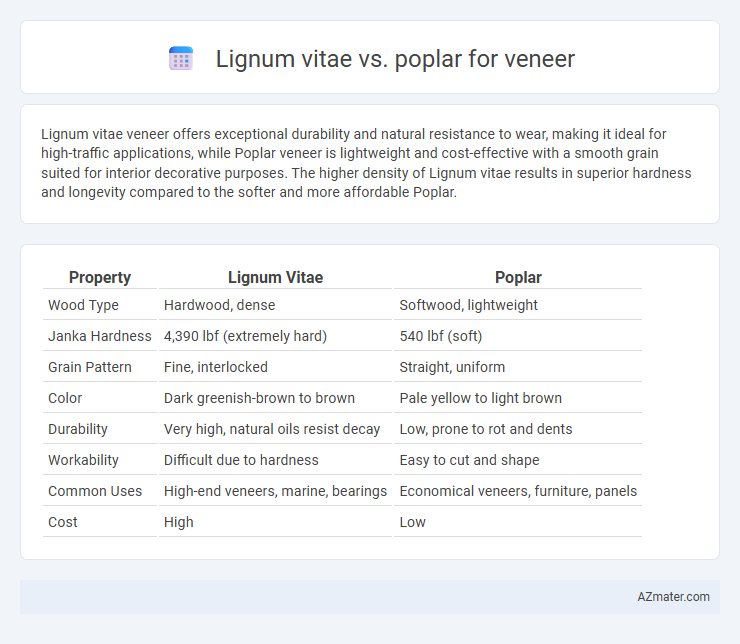Lignum vitae veneer offers exceptional durability and natural resistance to wear, making it ideal for high-traffic applications, while Poplar veneer is lightweight and cost-effective with a smooth grain suited for interior decorative purposes. The higher density of Lignum vitae results in superior hardness and longevity compared to the softer and more affordable Poplar.
Table of Comparison
| Property | Lignum Vitae | Poplar |
|---|---|---|
| Wood Type | Hardwood, dense | Softwood, lightweight |
| Janka Hardness | 4,390 lbf (extremely hard) | 540 lbf (soft) |
| Grain Pattern | Fine, interlocked | Straight, uniform |
| Color | Dark greenish-brown to brown | Pale yellow to light brown |
| Durability | Very high, natural oils resist decay | Low, prone to rot and dents |
| Workability | Difficult due to hardness | Easy to cut and shape |
| Common Uses | High-end veneers, marine, bearings | Economical veneers, furniture, panels |
| Cost | High | Low |
Introduction to Lignum Vitae and Poplar Veneer
Lignum vitae veneer is prized for its extreme density, natural oils, and rich, dark greenish-brown color, making it highly durable and resistant to wear and rot in premium woodworking projects. Poplar veneer offers a lighter, creamy white to yellow-green color with a fine, even grain, favoring applications requiring a smooth surface for staining or painting at a lower cost. Both veneers serve distinct purposes, with lignum vitae excelling in heavy-duty, decorative uses and poplar popular for economical, versatile interior finishes.
Botanical Overview and Sources
Lignum vitae (Guaiacum officinale) is a dense, hardwood from the Zygophyllaceae family, native to the Caribbean and northern South America, prized for its natural oils and durability. Poplar (genus Populus), belonging to the Salicaceae family, is a fast-growing, soft hardwood found primarily in North America, Europe, and Asia, commonly used for its lightweight and smooth texture in veneer production. Sourcing Lignum vitae often involves sustainable harvesting from specific tropical regions due to its limited distribution, whereas Poplar veneers are widely available from managed plantations, ensuring consistent supply and lower ecological impact.
Physical Characteristics Comparison
Lignum vitae veneer stands out for its extreme density and hardness, often exceeding 1,260 kg/m3, making it highly durable and resistant to wear. In contrast, poplar veneer is much lighter and softer, with a density around 450 kg/m3, resulting in easier workability but lower durability. The fine, interlocked grain of lignum vitae provides superior dimensional stability compared to poplar's straight, open grain, which may be prone to warping or denting.
Durability and Lifespan
Lignum vitae offers exceptional durability and an impressive lifespan due to its dense, oily, and resinous nature, making it highly resistant to rot, insects, and wear compared to poplar veneer. Poplar veneer, while more affordable and lightweight, is less durable and prone to dents and moisture damage, resulting in a significantly shorter lifespan under heavy use. Choosing lignum vitae for veneer applications ensures long-term performance and minimal maintenance, especially in high-wear environments.
Workability and Machining Properties
Lignum vitae offers exceptional durability and density, making it more challenging to machine but providing a smooth finish once properly worked, ideal for high-wear applications. Poplar, being softer and less dense, excels in workability and is easier to cut, shape, and sand, making it suitable for quick production and detailed veneer work. While Lignum vitae requires sharper tools and slower machining speeds, Poplar allows for faster processing but may lack the same depth of grain and strength in veneer applications.
Aesthetic Qualities and Grain Patterns
Lignum vitae veneer exhibits a rich, dark brown color with subtle greenish undertones, featuring a dense, interlocked grain pattern that creates a strikingly smooth and lustrous surface, ideal for high-end, luxurious applications. Poplar veneer offers a pale, creamy appearance with occasional green or purple streaks and a generally straight, uniform grain that provides a consistent, understated backdrop suitable for painted finishes or casual, rustic designs. The contrasting aesthetics and grain patterns of Lignum vitae and Poplar veneers cater to distinct design preferences, with Lignum vitae favored for opulence and durability, while Poplar is prized for versatility and cost-effectiveness.
Environmental Impact and Sustainability
Lignum vitae, known for its exceptional density and natural oils, offers long-lasting veneer with minimal chemical treatment, reducing environmental impact through enhanced durability. Poplar veneer, being fast-growing and widely available, supports sustainable forestry practices and carbon sequestration, making it a renewable option with lower ecological footprint. Choosing between the two depends on balancing Lignum vitae's longevity against Poplar's renewability and faster replenishment rates.
Common Applications in Veneer
Lignum vitae veneer is highly favored in marine applications and luxury furniture due to its exceptional hardness, natural oils, and resistance to water and wear. Poplar veneer, known for its lightweight and consistent grain, is commonly used in interior cabinetry, drawer components, and decorative panels where affordability and ease of finishing are prioritized. Both veneers serve distinct purposes, with Lignum vitae excelling in durability-focused projects and Poplar preferred for economical and versatile interior designs.
Cost and Availability Factors
Lignum vitae veneer is significantly more expensive due to its rarity and high density, often harvested from slow-growing trees native to the Caribbean. In contrast, Poplar veneer offers a cost-effective alternative, widely available from fast-growing North American plantations, making it more accessible for large-scale projects. Availability of Poplar ensures consistent supply, while Lignum vitae's limited sources can cause fluctuating prices and shortages.
Choosing the Right Wood for Your Veneer Project
Lignum vitae offers exceptional density and natural oiliness, making it highly durable and resistant to wear, ideal for high-end veneer projects requiring longevity and a rich, dark finish. Poplar features a softer texture and lighter color, providing an affordable, easily workable option preferred for painted veneers or lighter wood tones. Selecting between Lignum vitae and Poplar depends on your project's durability needs, aesthetic preferences, and budget constraints to ensure optimal performance and visual appeal.

Infographic: Lignum vitae vs Poplar for Veneer
 azmater.com
azmater.com